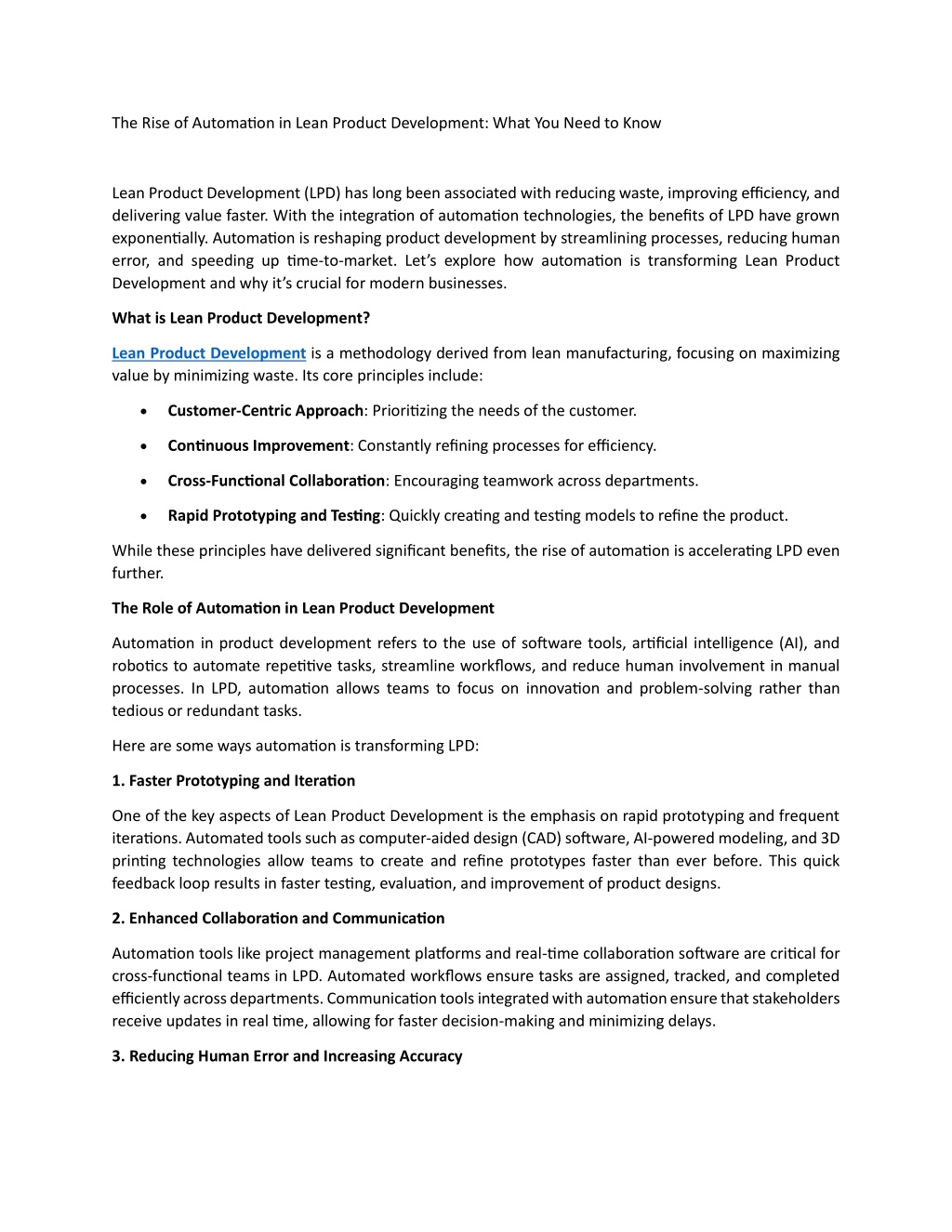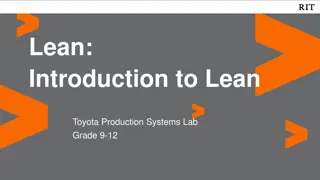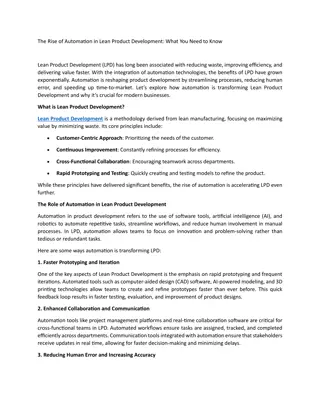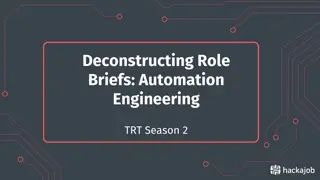
The Rise of Automation in Lean Product Development What You Need to Know
Yet, these tasks are often time-consuming and tedious, leading developers to either rush through them or avoid them altogether.
Download Presentation

Please find below an Image/Link to download the presentation.
The content on the website is provided AS IS for your information and personal use only. It may not be sold, licensed, or shared on other websites without obtaining consent from the author. Download presentation by click this link. If you encounter any issues during the download, it is possible that the publisher has removed the file from their server.
E N D
Presentation Transcript
The Rise of Automation in Lean Product Development: What You Need to Know Lean Product Development (LPD) has long been associated with reducing waste, improving efficiency, and delivering value faster. With the integration of automation technologies, the benefits of LPD have grown exponentially. Automation is reshaping product development by streamlining processes, reducing human error, and speeding up time-to-market. Let s explore how automation is transforming Lean Product Development and why it s crucial for modern businesses. What is Lean Product Development? Lean Product Development is a methodology derived from lean manufacturing, focusing on maximizing value by minimizing waste. Its core principles include: Customer-Centric Approach: Prioritizing the needs of the customer. Continuous Improvement: Constantly refining processes for efficiency. Cross-Functional Collaboration: Encouraging teamwork across departments. Rapid Prototyping and Testing: Quickly creating and testing models to refine the product. While these principles have delivered significant benefits, the rise of automation is accelerating LPD even further. The Role of Automation in Lean Product Development Automation in product development refers to the use of software tools, artificial intelligence (AI), and robotics to automate repetitive tasks, streamline workflows, and reduce human involvement in manual processes. In LPD, automation allows teams to focus on innovation and problem-solving rather than tedious or redundant tasks. Here are some ways automation is transforming LPD: 1. Faster Prototyping and Iteration One of the key aspects of Lean Product Development is the emphasis on rapid prototyping and frequent iterations. Automated tools such as computer-aided design (CAD) software, AI-powered modeling, and 3D printing technologies allow teams to create and refine prototypes faster than ever before. This quick feedback loop results in faster testing, evaluation, and improvement of product designs. 2. Enhanced Collaboration and Communication Automation tools like project management platforms and real-time collaboration software are critical for cross-functional teams in LPD. Automated workflows ensure tasks are assigned, tracked, and completed efficiently across departments. Communication tools integrated with automation ensure that stakeholders receive updates in real time, allowing for faster decision-making and minimizing delays. 3. Reducing Human Error and Increasing Accuracy
Repetitive tasks, such as data entry, testing, or analysis, can lead to human error and inefficiencies. Automation reduces the risk of errors by taking over these routine processes. Automated testing tools can simulate real-world conditions, providing accurate feedback and identifying issues that may not be caught manually. This ensures better product quality and minimizes defects. 4. Data-Driven Decision Making Automation enables teams to collect and analyze data in real time. AI and machine learning algorithms can process massive amounts of data to offer insights, such as customer preferences, product performance, or market trends. This data-driven approach allows LPD teams to make more informed decisions, improving product designs, reducing waste, and ensuring the product meets customer needs. 5. Accelerating Time-to-Market In a competitive landscape, speed is critical. Automation in LPD speeds up every phase of the development process design, prototyping, testing, and production. Automated tools eliminate bottlenecks and reduce the time spent on manual processes, allowing companies to deliver products to market faster, with greater precision and fewer resources. Challenges of Automation in Lean Product Development While automation offers clear benefits, it also presents challenges: Initial Investment: Implementing automation technologies requires upfront investment in tools and training. Integration: Automation tools must integrate seamlessly with existing systems, which can be complex and time-consuming. Workforce Adaptation: Employees must adapt to new technologies, requiring retraining and a shift in mindset towards more strategic tasks. Conclusion Automation is revolutionizing Lean Product Development, driving greater efficiency, accuracy, and speed. By automating repetitive tasks, enabling data-driven decisions, and enhancing collaboration, businesses can create high-quality products faster and with fewer resources. However, successful integration of automation requires careful planning, investment, and workforce adaptation. For organizations aiming to stay competitive in today s fast-paced market, embracing automation in LPD is no longer optional it s a necessity. Read product.html More: https://techhorizonsolutions.blogspot.com/2024/09/the-rise-of-automation-in-lean-






















